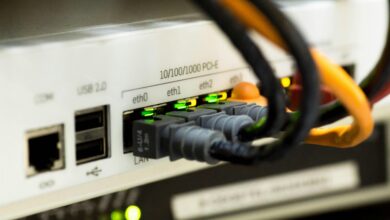The Latest Trends in Cybersecurity Technology

In today’s digital age, cybersecurity is more critical than ever. As technology evolves, so do the threats posed by cybercriminals. Organizations and individuals must stay ahead of these threats by adopting cutting-edge cybersecurity technologies and strategies. In this guide, we’ll explore the latest trends in cybersecurity that are shaping the industry and helping to protect sensitive data, systems, and networks from increasingly sophisticated attacks.
1. Artificial Intelligence (AI) and Machine Learning (ML)
Why It Matters:
AI and ML are revolutionizing cybersecurity by enabling faster detection and response to threats. These technologies can analyze vast amounts of data to identify patterns, anomalies, and potential risks that traditional methods might miss.
Key Applications:
- Threat Detection : AI-powered tools can detect malware, phishing attempts, and unusual network activity in real time.
- Behavioral Analysis : ML algorithms learn normal user behavior and flag deviations that could indicate a breach.
- Automated Response : AI systems can automatically isolate compromised devices or block malicious traffic without human intervention.
Example:
Darktrace uses AI to mimic the human immune system, identifying and neutralizing threats as they emerge.
2. Zero Trust Architecture
Why It Matters:
The traditional “trust but verify” model is no longer sufficient in an era of remote work and cloud-based infrastructure. Zero Trust Architecture operates on the principle of “never trust, always verify,” ensuring that every user and device is authenticated and authorized before accessing resources.
Key Features:
- Continuous Verification : Users are re-authenticated periodically, even after initial login.
- Micro-Segmentation : Networks are divided into smaller zones to limit lateral movement by attackers.
- Least Privilege Access : Users are granted only the permissions necessary for their roles.
Example:
Google’s BeyondCorp is a widely recognized implementation of Zero Trust, eliminating the need for traditional VPNs by securing access at the application level.
3. Extended Detection and Response (XDR)
Why It Matters:
Traditional security tools often operate in silos, making it difficult to correlate data across endpoints, networks, and applications. XDR integrates multiple layers of security into a unified platform, providing a holistic view of threats.
Key Benefits:
- Centralized Visibility : Combines data from email, endpoints, servers, and cloud environments.
- Faster Incident Response : Automates threat hunting and remediation processes.
- Improved Context : Provides deeper insights into attack vectors and tactics.
Example:
Palo Alto Networks’ Cortex XDR offers advanced analytics and automation to streamline threat detection and response.
4. Cloud Security Innovations
Why It Matters:
As businesses migrate to the cloud, securing cloud environments has become a top priority. New technologies are emerging to address the unique challenges of cloud security.
Key Trends:
- Cloud-Native Security Tools : Solutions like AWS Shield and Azure Security Center provide built-in protection for cloud platforms.
- Cloud Access Security Brokers (CASBs) : Monitor and control data moving between on-premises and cloud environments.
- Serverless Security : Protects functions and APIs in serverless architectures, which are increasingly targeted by attackers.
Example:
Snyk focuses on securing cloud-native applications by identifying vulnerabilities in code and dependencies.
5. Quantum Cryptography
Why It Matters:
With the advent of quantum computing, traditional encryption methods may become obsolete. Quantum cryptography leverages the principles of quantum mechanics to create unbreakable encryption keys.
Key Advantages:
- Unhackable Keys : Quantum key distribution (QKD) ensures that any attempt to intercept keys alters their state, alerting users to eavesdropping.
- Future-Proofing : Prepares organizations for the post-quantum era.
Example:
IBM and Toshiba are leading efforts to develop practical quantum cryptographic solutions.
6. Biometric Authentication
Why It Matters:
Passwords are vulnerable to breaches, phishing, and brute-force attacks. Biometric authentication provides a more secure and convenient alternative by verifying identity through physical traits.
Common Methods:
- Fingerprint Scanning
- Facial Recognition
- Voice Recognition
- Iris Scanning
Emerging Innovations:
- Behavioral Biometrics : Analyzes typing patterns, mouse movements, and other behavioral traits to detect fraud.
- Multi-Modal Biometrics : Combines multiple biometric factors for enhanced security.
Example:
Apple’s Face ID and Microsoft’s Windows Hello are popular implementations of biometric authentication.
7. Decentralized Identity Management
Why It Matters:
Centralized identity systems, such as those managed by corporations or governments, are attractive targets for hackers. Decentralized identity management gives individuals control over their personal data using blockchain technology.
Key Features:
- Self-Sovereign Identity (SSI) : Users store credentials in digital wallets and share them selectively.
- Immutable Records : Blockchain ensures tamper-proof verification of identities.
- Reduced Fraud : Eliminates reliance on third-party identity providers.
Example:
Microsoft’s ION project uses Bitcoin’s blockchain to enable decentralized identity solutions.
8. Ransomware Defense Strategies
Why It Matters:
Ransomware attacks have surged in frequency and sophistication, targeting businesses, hospitals, and even governments. New defense strategies focus on prevention, detection, and recovery.
Key Approaches:
- Backup and Recovery Plans : Regularly back up data and test restoration processes.
- Endpoint Detection and Response (EDR) : Monitors devices for signs of ransomware activity.
- Deception Technology : Deploys decoy files and systems to mislead attackers.
Example:
CrowdStrike Falcon combines EDR with AI to stop ransomware in its tracks.
9. Cybersecurity Mesh Architecture
Why It Matters:
Traditional perimeter-based security models struggle to protect distributed workforces and hybrid IT environments. Cybersecurity mesh architecture decentralizes security controls, allowing them to be applied wherever assets reside.
Key Components:
- Distributed Enforcement Points : Security policies are enforced close to the asset being protected.
- Scalability : Adapts to changing organizational needs.
- Interoperability : Integrates with existing tools and frameworks.
Example:
Gartner predicts that by 2025, 50% of digital access control requests will be handled by cybersecurity mesh architectures.
10. Privacy-Enhancing Technologies (PETs)
Why It Matters:
As privacy regulations like GDPR and CCPA gain traction, organizations are adopting privacy-enhancing technologies to safeguard user data while maintaining compliance.
Key PETs:
- Data Anonymization : Removes personally identifiable information (PII) from datasets.
- Homomorphic Encryption : Allows computations on encrypted data without decrypting it.
- Differential Privacy : Adds noise to datasets to prevent identification of individuals.
Example:
Google’s Federated Learning enables machine learning models to train on decentralized data without exposing raw information.




